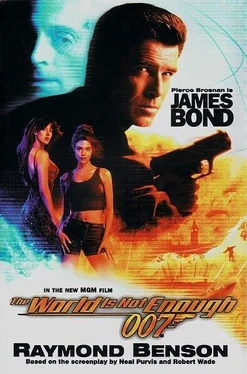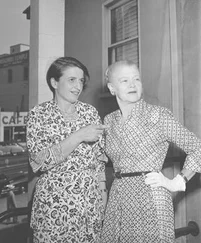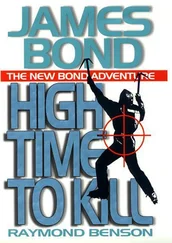In a few moments, it was over. There was an eerie silence, save for the occasional groan of hull stress and the wail of alarms.
Renard, dazed, looked up and saw that the extruder had slid into Truhkin and killed him . . . but he was holding the finished plutonium control rod in his clenched fists. Rcnard got up and wrenched it free. He then made sure that the hatch to the control room was sealed.
Bond and Christmas climbed out of the netting just as a horrible creak resounded through the chamber. A rupture at the end of the racks of torpedoes spread across the wall; water gushed toward them at a frightening rate.
‘Climb!’ he shouted. He pulled Christmas up and they ascended toward the control room. ‘Keep moving!’
As they emerged into the demolished chamber, the water was already pouring through the hatch, splashing at their feet. They struggled together to shut the hatch, but by the time they were successful, the water was up to their knees.
Renard climbed to the reactor room and, without flinching, he opened the cover of the glaring reactor. He was bathed in a ghostly blue light.
Renard was no nuclear physicist, but he understood enough about reactors to get the job done. A reactor’s only real purpose, he knew, was to generate heat to boil water into saturated steam. The only difference between it and any other type of steam-powered turbine plant was the amount of energy concentrated in the nuclear fuel in the reactor core, as well as the complete lack of any need for air.
The process of nuclear fission was really quite simple. An atom was split and released two neutrons, generating energy as heat. When the two neutrons hit two more atoms, four more neutrons were thrown, and so on, until the result was an uncontrolled, supercritical fission reaction. An atomic explosion.
However, Renard knew that, here in the submarine, the amount of energy released by the splitting atoms was controlled by control rods that were made of a neutron-absorbing material such as cadmium or hafnium. These rods were set to absorb the right amount of neutrons to bring the reaction into controlled, critical fission. This reaction still generated a great deal of heat, boiling water into saturated steam to power the sub’s turbines, but the process could continue safely for years.
Renard stared at the glowing reactor core, transfixed momentarily by the power it held. He studied it carefully, picking out what he presumed to be the uranium fuel elements that had been formed into plates to allow maximum heat transfer to the primary coolant loop. They were mounted parallel to each other in an assembly mounted on top of a support structure in the base of the reactor vessel. In between the fuel elements were the control rods, designed to drop into place in the event of a reactor problem. The coolant of the primary loop circulated around the core, feeding the heated coolant into a steam generator. This, in turn, directed the steam into a secondary cooling loop that fed a pair of high- pressure turbines in the machinery spaces. There, the steam was condensed into water and sent back into the steam generator. The turbines were responsible for turning the main propeller shaft, as well as providing electrical power to the boat and its equipment.
Renard held the plutonium control rod and prepared himself for what he had to do. The job would have to be performed slightly ahead of schedule . . .
The submarine lurched again and threw him down. He struggled to get back up to the reactor but found it to be exhausting. For some inexplicable reason, he felt real pain on the side of his head where he had been shot It was odd to actually feel something there after so long. Was the bullet moving? Was the time the doctor had given him now up? No! He would finish Elcktra’s plan!
He stared into the violet blue heat, mesmerised by its beauty. It was almost as beautiful as she . . .
He pressed a button and one of the neutron-absorbing control rods slowly rose from the reactor. He reached out and released it from its berth, then threw it across the room. Renard carefully picked up the plutonium rod and prepared to insert it into the orifice left by the rod he had removed.
He smiled, but the pain in his head overpowered him.
Back in the control room, Christmas noticed a panel light.
‘Oh my God, he’s opened up the reactor.’ Bond studied the panel as she interpreted more lights. ‘And he’s sealed himself in.’
‘And us out,’ Bond said.
‘He’s already withdrawn one of the control rods. He’s going to insert the plutonium. What do we do?’
Thinking fast, Bond moved to the controls near the tanks. He took four seconds to study them, then began to hit switches. He examined a control panel that was marked, in Russian, ‘Forward and Aft Escape Chambers’. He looked around the room and saw that the Forward Escape hatch was located there, as well as a cabinet on the wall.
‘Look in there for re-breathers,’ he said, pointing. She opened the cabinet and found that they had been ripped to shreds.
‘Sabotaged,’ she said. ‘No one was meant to get off the sub alive.’
i never liked those things anyway,’ he said. He pushed a button on the panel.
The Aft Escape hatch opened, high up on the sub. Water flooded the escape chamber there, but an inner door stopped it from getting into the submarine.
She suddenly understood what he was planning to do and looked at him questioningly.
‘You have a better idea?’ he snapped. He opened the inner door to the Forward Escape Chamber and said, ‘Count to twenty. When you get to twenty, push this button. It will open the inner door of the Aft Escape hatch. It can only be opened for a few seconds or we’ll sink.'
‘But what if. . .?’
‘Count to twenty. I’ll be there. Wait five more seconds, then press the purge button. That will empty the water out of the chamber.’
He got inside the hatch and she sealed the door behind him, wrenching a lever that immediately flooded his chamber with water. Bond held his breath as the water poured in. It was extremely claustrophobic, but he had been in tight spots before.
A green light flashed on the control panel. Christmas punched a button and the outer Forward Escape hatch opened. Bond burst out into the dark water and began the long, torturous ascent up the outside of the submarine.
‘One, one-thousand, two, one-thousand,’ Christmas began to chant.
It was very disorienting. There was very little illumination and Bond had difficulty getting his bearings against the vast, black vertical whale next to him. He might have got lost if he hadn’t recognised the conning tower jutting out sideways.
‘Fourteen, one-thousand, fifteen, one-thousand . . .’
His lungs felt as if they would explode. He had to be almost there! Where was the bloody thing?
‘Seventeen, one-thousand . . .’
There it was - the open hatch of the Aft Escape Chamber! He swam inside then yanked the lever to close the hatch.
Christmas was shivering in the rising water.
‘ . . Twenty, one-thousand.’ She pressed the button.
The inner hatch opened, and Bond collapsed into the sub . . . but the chamber was full of water. Now all Christmas had to do was press the ‘purge’ button.
However, before she could do so, the hatch leading to the deck above split open with a tremendous shriek. She was hit with a torrent of water, knocking her off her feet.
In the chamber above, Bond was running out of breath. Where the hell was she? Press the purge button!
Christmas struggled to get back to the controls, but she tripped over the body of a dead seaman. She recoiled in terror, then realised the man couldn’t hurt her. The water was rising quickly, now over her head. She ducked into it, reached for the controls and hit the button.
Читать дальше











